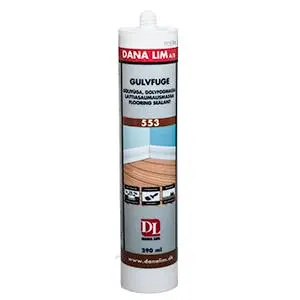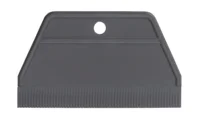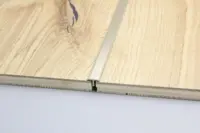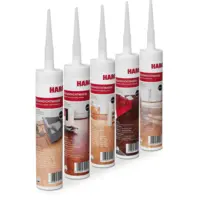Dana Lim Gulvfugemasse 553
Produktbeskrivelse & anvendelse: Gulvfugemasse 553 tilhører den nye generation af MS-polymer fugemasser, der kombinerer de bedste egenskaber fra silicone- og polyurethan-fugemasser. Fugemassen hærder ved en reaktion med luftens fugtighed, og danner en elastisk fuge, der kan optage bevægelser på op til +/- 25 %. Gulvfugemasse 553 er specielt udviklet til fugning af trægulve og færdigparket, samt til tætninger mellem gulv og andre bygningsdele, f.eks. vægge, trapper, søjler m.m. Fugemassen kan slibes, og lakeres med de fleste sædvanlige vandog spritbaserede gulvlakker. Gulvfugemasse 553 er absolut lugtfri, neutral og hurtighærdende.
Fysiske / kemiske data:
Indhold: 290 ml patron
Farver: Lys eg, Mørk Eg og Sort
Type: MS-hybrid polymer, 1-komponent
Fungicidbehandlet: Nej
Vægtfylde: Ca. 1,4 kg/liter
Holdbarhed: 12 måneder i uåbnet emballage ved tør og kølig opbevaring.
Brugsanvisning:
Dimensionering af fugen: Fuger hvortil der anvendes Gulvfugemasse 553 bør dimensioneres således at bevægelsen af den frie fugesubstans er under +/- 25 %. Ved anvendelse i gulvfuger skal man sikre sig at fugens bredde er tilstrækkelig til at optage de temperatur- eller fugtbetingede bevægelser samt eventuelle sætninger, der kan forekomme i gulvet. Desto smallere fugen er, desto større påvirkninger vil der komme på fugefladerne, hvilket øger risikoen for fugeslip. Den ideelle fugestørrelse er ca. 10 mm. Ved fugebredder op til 10 mm skal fugens tværsnit være kvadratisk. Ved fugebredder over 10 mm skal dybden være 2/3 af bredden. Det er vigtigt at undgå vedhæftning i bunden af fugen. Som underlag for fugen anvendes derfor enten PE-tape, eller traditionel rund fugebund hvis også fugens dybde skal justeres. Endelig er det muligt at bruge ovntørret kvartssand som underlag, men det kræver en del øvelse af fuge mod en sådan bund.
Forberedelse af materialer: Fugesiderne skal være rene, tørre, fri for slipmiddel, fedtstof, støv og løse partikler. Har gulvet være fuget tidligere, skal gammelt fugemateriale fjernes fuldstændig. For optimal vedhæftning anbefales det at anvende en overfræser for at renskære gulvbræddernes fugeflade. For at sikre højst mulig styrke, primes fugefladerne med Primer 961. Bemærk at Primer 961 ikke kan anbefales på olieholdige gulvflader udendørs.
I nedenstående oversigt er der angivet forbruget af primer i ml pr. løbende meter fuge.
Fugedybde 6 mm. 0,7 ml. pr. meter fuge
Fugedybde 8 mm. 1,4 ml. pr. meter fuge
Fugedybde 10 mm. 1,7 ml. pr. meter fuge
Fugedybde 12 mm. 2,1 ml. pr. meter fuge (*Alle forbrug er retningsgivende.)
Det anbefales at der anvendes afdækningstape før påføring af primer og fugemasse. Det anbefales at udføre test i hvert enkelt tilfælde.
Anvendelsesbetingelser: Kan påføres ved temperaturer fra +5 °C til +40 °C og en relativ luftfugtighed på minimum 30%.
Påføring: Patronens gevindtop afskæres med en skarp kniv, hvorefter selve fugespidsen tilskæres med et skråt snit, der er lidt mindre end fugens bredde. Fugemassen påføres ved hjælp af hånd- eller trykluft pistol. Efter påføring trykkes fugen på plads, og glittes med en sæbevands mættet fugepind. Afdækningstape fjernes straks efter at fugen er færdigbearbejdet.
Hærdning: Hindedannelse: Ca. 30 min. ved 20 °C og 50 % RF. En fuge på 10 x 10 mm er afhærdet på 5 dage ved 20 °C og 50 % RF. Fugemassen hærder langsommere ved lavere temperaturer og lavere luftfugtighed.
Efterbehandling
Overmaling / lakering: Fugemassen kan overmales eller lakeres efter ca. 1 døgn. Bedste resultat opnås hvis behandling foretages indenfor få døgn. Gulvfugemasse 553 kan lakeres med de fleste vand- og spritbaserede lakker. Produkterne må ikke indeholde terpentin eller lign. Opløsningsmidler. Vær opmærksom på, at gulvets bevægelser optages af fugemassen, og således giver risiko for revnedannelser i lakken, hvis ikke den er tilstrækkelig fleksibel. Hvis lakering først kan / skal foretages flere dage efter fugning, anbefales det at fugen aftørres med sprit umiddelbart inden lakering. På grund af de mange forskellige produkter på markedet, anbefaler vi altid at man udfører en prøve med den ønskede maling/lak.
Lud- & oliebehandling: Fugemassen kan lud- og oliebehandles når den er helt gennemhærdet. Produkterne må ikke indeholde terpentin eller lign. opløsningsmidler. Bemærk at lud/olie ikke trænger ned i fugemassen, og fugerne skal derfor aftørres med en klud. På grund af de mange forskellige produkter på markedet, anbefaler vi altid at man udfører en prøve med den ønskede olie/ lud.
Slibning: Fugemassen kan først slibes når den er helt gennemhærdet.
Rengøring: Værktøj rengøres - og fugemasse fjernes - med f.eks. benzin eller terpentin. Hærdet fugemasse kan kun fjernes mekanisk. Hænder og hud vaskes med vand og sæbe.
Anvendelsesområder: • Gulvfuger • søjler mm. • trapper • Gulv mod væg
Egenskaber: • Lakerbar • Bevægelse +/- 25 % • Slibbar • Højelastisk • Neutralhærdende
Download:
Produktinformation
Sikkerhedsblad















